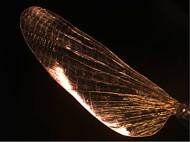Shrilks – amazing new material inspired by insect cuticle
 Researchers at the Wyss Institute for Biologically Inspired Engineering at Harvard University have applied biomimicry of insect cuticle – tough but flexible, non-mineral outer coverings that provide protection – to develop a similar material they named Shrilk. The new material is able to mimic the exceptional strength, toughness, and versatility of the extraordinary material, while being low-cost, biodegradable, and biocompatible.
Researchers at the Wyss Institute for Biologically Inspired Engineering at Harvard University have applied biomimicry of insect cuticle – tough but flexible, non-mineral outer coverings that provide protection – to develop a similar material they named Shrilk. The new material is able to mimic the exceptional strength, toughness, and versatility of the extraordinary material, while being low-cost, biodegradable, and biocompatible.
Insect cuticle is a composite material consisting of layers of chitin, a polysaccharide polymer, and protein organized in a laminar (plywood-like structure). Mechanical and chemical interactions between these materials provide the cuticle with its unique mechanical and chemical properties that enable insects to protect themselves, and provide structure for the insect’s muscles and wings.
By mimicking this laminar design in the lab, the researchers were able to engineer a thin, clear film that has the same composition and structure as insect cuticle. The material is composed of chitin (a material which is commonly extracted from discarded shrimp shells) and fibroin protein from silk, and that composition led to its name – Shrilk.
The new material has similar properties as an aluminum alloy with only half the weight of the same. Shrilk is biodegradable, and can be produced at a very lost cost from natural materials, since chitin is readily available as a shrimp waste product and silk is renewable. By varying the water content in the fabrication process, the researchers were able to alter material’s elasticity and rigidity, thus reproducing the wide variations the natural material exhibits. It is also easily molded into complex shapes, such as tubes.
“When we talk about the Wyss Institute’s mission to create bioinspired materials and products, Shrilk is an example of what we have in mind”, said Wyss Institute Founding Director Donald Ingber, M.D., Ph.D. Ingber is the Judah Folkman Professor of Vascular Biology at Harvard Medical School and Children’s Hospital Boston and is a Professor of Bioengineering at the Harvard School of Engineering and Applied Sciences. “It has the potential to be both a solution to some of today’s most critical environmental problems and a stepping stone toward significant medical advances.”
Since it is cheap and degradable, Shrilk could be used as an alternative for plastics used in consumer products, and replace plastic trash bags, packaging, or even introduce new kind of diapers that could degrade quickly. Given that it is biocompatible, light and an exceptionally strong material, it could be also used in various medical applications.
For more information, read the article published in the journal Advanced Materials named: “Unexpected Strength and Toughness in Chitosan-Fibroin Laminates Inspired by Insect Cuticle”.









Hmm, how are these biocompatible implants going to influence people with shellfish allergies?
A case of biomimicking.
Dr.A.Jagadeesh Nellore (AP),India
E-mail: anumakonda.jagadeesh@gmail.com